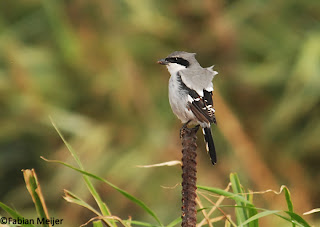24th of July:
While we're driving on a dirt track I see a large bird circling. As the light is not that good yet, I first think it's a Raven but it turns out to be a nice female Barbary Falcon!
As we drive on we suddenly discover a Houbara Bustard walking in front of the car! The bird sees us and walks away but it's not shy and starts foraging at a good range! Our first close encounter!
Houbara Bustard (Chlamydotis undulata fuerteventurae)
Next stop is Haría where we visit the cultivated fields south of the village. From Haría we walk a path towards the north (this path eventually goes up into the Barranco). As we'd observed before, there are many Spectacled Warblers around and we are offered some good photo oppertunities:
Spectacled Warblers (Sylvia conspictilla)
We see 5 Fuerteventura Blue Tits. These show really well, just like the warblers:
Fuerteventura Blue Tit (Cyanistes degener)
When we're almost back at the car we see large panic amognst the Feral/Rock Pigeons. It doesn't take long for us to see what's the cause: a (presumably) pair of Barbary Falcons is hunting them! We don't see if they have any succes as they disseappear to the cliffs after a while.
We drive back through the Barranco the Chafaris again, where we see another 4 Fuerteventura Blue Tits. Also we observe 4 different Eleonora's Falcons at the same spot where we saw the one the day before. They're hunting above a small reservoir of water in a corner of the barranco. They're hunting on dragonflies and showing well. Great raptors! Later on the photos we see that one of the falcon's is ringed, where would this bird come from??
Bad light...
And in the mean time an Egyptian Vulture passed by:
Egyptian Vulture (Neophron percnopterus majorensis)
In the early evening we visit Jameos del Agua. A cave with shallow water. It's a really nice place with the endemic Blind Crabs, that occur in the water in the cave. We see tens of them in the water, really special. A must to visit! A Fuerteventura Blue Tit is observed in the gardens there and over a 1000 Cory's Shearwaters pass by.
One of the Blind Crabs
Fuerteventura Blue Tit (Cyanistes degener)
A Grey Heron is observed flying over the highway near Guatiza on our way back.
What what what what a great day!



























































